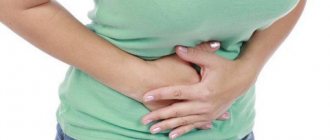Manganese is a universal substance that disinfects well and has a detrimental effect on pathogenic microorganisms. Gastric lavage with potassium permanganate is done not only for adults, but also for children. In this procedure, the most important thing is to prepare the solution correctly so that burns to the mucous membrane of the digestive organs do not occur. Washing with a solution of potassium permanganate can be done at home, but only if the patient is conscious and his condition is satisfactory. For young children, this manipulation is performed only in a hospital setting.
Potassium permanganate - what is it?
Potassium permanganate is usually called dark purple crystals. When the product gets into the water, it begins to dissolve, coloring it. In medicine, potassium permanganate is called potassium permanganate.
The main property of such a powder is its antiseptic effect, which appears due to the possibility of the appearance of active oxygen.
Today there are practically no analogues to such a powder that will react with ordinary water and treat people in case of poisoning. The main property of potassium permanganate in case of poisoning is its oxidizing effect.
After entering the stomach, the solution triggers the following processes:
- All chemical compounds begin to take on a form that is not dangerous to the body. Washing as a result of alcohol poisoning is especially useful.
- Inside the stomach, a solution of potassium permanganate is capable of destroying various bacteria, which become the culprits for the deterioration of a person’s condition.
Before using potassium permanganate, it is recommended to find out how to properly make the medicinal liquid and what contraindications there may be.
The effect of potassium permanganate in various types of poisoning
The popularity of potassium permanganate (common name - potassium permanganate) is due to its good work with chemical poisoning and organic intoxication. Gastric lavage with a manganese solution quickly deactivates harmful substances, stopping the absorption of the poison.
Food poisoning. Contact of potassium permanganate with organic matter forms active oxygen. Aggressively oxidizes biological compounds, destroying cell walls. Breaks down bacteria and viruses, potassium permanganate solution acts as a powerful antiseptic. Organic toxins are broken down and washed out through vomiting.
Chemical poisoning. If intoxication with minerals/chemicals occurs, gastric lavage will neutralize the active ingredient. Rapidly oxidizing, the poison will stop acting.
Alcohol poisoning. Oxidation of chemicals and organics works great in case of alcohol overdose. Harmful ingredients are converted into safe ones as soon as potassium permanganate is in the stomach.
How can I replace potassium permanganate?
If it is impossible to use potassium permanganate, you can resort to medications - special enterosorbents that absorb harmful substances well and quickly remove harmful substances from the body:
- Enterosgel.
- Activated carbon.
- Polyphepan.
- Smecta.
- Carbolong.
The drugs detoxify the body, actively bind harmful substances and remove them. In rare cases, such as cyanide poisoning, EDTA (ethylenediaminetetraacetic acid) salts are used as an antidote.
Solutions you can use at home:
- baking soda - diluted in a ratio of 1 tbsp. l. powder per 1 liter of warm water;
- bitter salt (magnesia) dissolved in water - proportion 1:10;
- citric acid, 1 tsp. l. which dissolves in 1 liter of water.
Treatment with potassium permanganate
The first thing people resort to for throat diseases, intestinal disorders, and poisoning is potassium permanganate (potassium permanganate, potassium permanganate). During the Great Patriotic War, like cartridges for a soldier, it was in the bags of orderlies and paramedics and was widely used in the treatment of wounds in hospitals. The action of potassium permanganate is based on its ability to oxidize organic substances, releasing oxygen. This is due to the antimicrobial and antiseptic effect of potassium permanganate. An aqueous solution of potassium permanganate has anti-inflammatory properties. In various concentrations, this solution is used for washing wounds, rinsing the mouth and throat, for lubricating ulcerative and burn surfaces, and for douching. The range of applications of potassium permanganate is quite wide. Even with the availability of many new synthetic agents, it is still indispensable “in” gynecological, urological, and dermatological practice. In the table of antidotes for poisoning, potassium permanganate is one of the most important means of first aid. However, with all the advantages of potassium permanganate, it must be handled with care. In high concentrations, it cauterizes and causes swelling of the mucous membranes of the mouth, pharynx, esophagus, stomach, intestines, vomiting and diarrhea. Therefore, the solution should be used with caution. Our grandmothers also knew the useful properties of potassium permanganate in everyday life: they washed wounds with it, treated poisoning, disinfected it, bathed babies, and even used it to control pests in the garden. Such widespread use of potassium permanganate explains its main property - it is an antifungal and antimicrobial drug. Due to active oxidation processes, potassium permanganate kills harmful microbes - causative agents of various infections both on the surface of the skin and inside the body. Healing properties of potassium permanganate (potassium permanganate) Potassium permanganate is an effective disinfectant. A solution of potassium permanganate (potassium permanganate) has antiseptic properties and is capable of neutralizing the toxic effect on the body of such toxic compounds as aconitine, morphine, other alkaloids, phosphorus (when taken orally). Potassium permanganate is one of the types of permanganates (from the Latin manganum - “manganese”) - permanganate salts. This chemical is widely used both for household purposes and for medicine. Potassium permanganate is dark purple crystals, highly soluble in water (depending on the concentration, the color can be from light pink to red-violet), methyl alcohol, acetic acid and acetone. In everyday life, potassium permanganate dissolved in water is called potassium permanganate. Treatment with potassium permanganate in medicine Neutralization of hydrocyanic acid (a toxic substance) with potassium permanganate occurs only in an alkaline environment. Potassium permanganate is a strong oxidizing agent. An aqueous solution of potassium permanganate has a strong disinfecting and drying effect; it is widely used in dermatological and surgical practice. When the first signs of gastritis and gastroenterocolitis appear, first of all you need to rinse the stomach using a weak (slightly pink) solution of potassium permanganate. To lavage the stomach in adults and even children, it is not necessary to use a probe; it is enough to simply give the patient the prepared solution in an amount of 0.5 - 2 liters to drink, and then reflexively induce vomiting. In case of poisoning, when it is necessary to induce vomiting as quickly as possible, the victim is given a pink solution of potassium permanganate to drink, which is also a medicinal disinfectant for the gastrointestinal tract. The solution is often prepared “by eye”, but the main recommendations are 10 crystals per 1 liter of water; further strength of the solution can be adjusted according to its color. It is very important that all crystals are dissolved in water before use, otherwise undissolved crystals may cause a burn if they come into contact with the skin or internal organs. The most popular solution is potassium permanganate for poisoning. At the first signs, including diarrhea, the patient is offered a solution of potassium permanganate, which stimulates bowel cleansing. Potassium permanganate for oral use in case of poisoning is prepared in the ratio of 2 crystals per cup of water, this solution is drunk. Thanks to its antiseptic properties, this medicine stops the source of infection in the stomach. Potassium permanganate - application in urology, gynecology Due to its antiseptic and antimicrobial abilities, a solution of potassium permanganate is used in the treatment of fungal and bacterial diseases in urology and gynecology. Potassium permanganate is used for thrush, when a weak solution is prescribed for daily douching. For urological problems in men associated with external inflammatory processes, rinsing with a solution of potassium permanganate is prescribed. When used in urology and gynecology, it is important to follow the rules for preparing the solution and ensure that the potassium permanganate crystals are completely dissolved. Otherwise, when crystals come into contact with the mucous membrane, they can cause even greater irritation. Potassium permanganate - contraindications It is not recommended to use a solution of potassium permanganate if you are hypersensitive. This can be immediately understood by the presence of side effects - swelling, discoloration of mucous membranes, sharp pain when taken orally, convulsions, etc. If such or other unpleasant symptoms are present, taking potassium permanganate should be stopped. Due to its oxidizing properties, potassium permanganate is absolutely incompatible with the use of coal, sugar and other substances that easily oxidize. It is important to store potassium permanganate crystals away from easily oxidizing substances, otherwise their contact can lead to an explosion and even a fire. Treatment with potassium permanganate (potassium permanganate) in folk medicine Treatment with potassium permanganate in folk medicine to eliminate pain caused by calluses. To do this, add table salt to a solution of pink potassium permanganate and, after pouring the solution into a basin, lower your feet into it for 20 minutes; after the procedure, you do not need to wipe your feet. After some time, the pain in the callus area will go away. In no case should you use a highly concentrated solution (purple color) for treatment with potassium permanganate, as this can lead to harm to health, burns of the skin and mucous membranes, and poisoning. Hygienic baths with potassium permanganate have a good therapeutic effect for diaper rash, including in infants: the water should be pink and warm. If there is excessive sweating of the lower extremities, unpleasant odors, purulent calluses, a warm foot bath with salt and potassium permanganate will help; after the procedures, the feet should be wiped well and sprinkled with talcum powder. Treatment with potassium permanganate is actively used for washing open wounds, including festering ones. For dermatitis characterized by the appearance of blisters, the skin should be washed with a pink solution of potassium permanganate. If you hold the cups for too long when placing the cups, purple spots and even blisters filled with ichorous fluid may form on the skin. In such cases, it is useful to lubricate the affected areas with a 5-10% solution of potassium permanganate. Treatment with potassium permanganate in practice: the best recipes In advanced cases of hemorrhoids, you can prepare a healing solution. Required: 1 tsp. baking soda, 1 tbsp. l. any vegetable oil, potassium permanganate, 3 liters of water. Preparation. Pour enough potassium permanganate into hot water to get a pink color, add soda, oil, pour the solution into the bath. Application. Take a bath for 20 minutes at night. Carry out the procedure daily for a week. In folk medicine there is a recipe for treating dysentery with potassium permanganate. This product contains several crystals of potassium permanganate per 0.5 liter of water. It is advised to increase the concentration of the solution depending on age (for infants - a pale pink solution, and for adults - a raspberry solution). It is recommended to take this solution orally, combining this with the enema procedure. It must be borne in mind that potassium permanganate becomes explosive when interacting with various organic substances. Therefore, its crystals should be stored in clean glass containers with ground-in stoppers, and the solution should be stored in dark glass bottles, since it easily decomposes under the influence of sunlight and daylight. When using the solution, difficult to wash off stains often remain on the skin and linen. To eliminate them, the skin can be washed with a solution of ammonium sulphide in a concentration of 1:5, and then with hot water. Stains are removed from linen with a solution of oxalic acid (1:9), a 2% solution of hydrochloric acid, vinegar or lemon juice.. It turns out that potassium permanganate is not so easy to purchase. In one pharmacy I was told that potassium permanganate was equated (by relevant orders) to explosives and that an appropriate license was needed to sell it; in another pharmacy they said that potassium permanganate was classified as a narcotic substance and, again, an appropriate license was needed. At the same time, everyone pointed to one pharmacy in the city where they make medicines to order (“maybe you can buy them there”). Still others say that the average person will be sold potassium permanganate only in solution, and in the form of crystals can only be bought according to the “red” recipe, and that all these sales bans are supposedly due to drug addicts who bought potassium permanganate en masse to purify their brew. If pharmacies do not sell potassium permanganate, then it can be found in veterinary and hardware stores. Where the seeds and fertilizers are.
Indications and contraindications
Many people know that potassium permanganate in case of poisoning can quickly alleviate a person’s condition. For treatment, two types of solution are used:
- Weak.
- Strong.
For ordinary food poisoning or light chemicals, it is recommended to use a weak solution of potassium permanganate. A strong solution is used very rarely and is more often used externally.
Using a strong product, wounds and purulent skin areas are wiped. It can also be used to treat burns.
Despite the benefits of the product, potassium permanganate cannot always be used and you need to know some contraindications for using the product:
- The solution should not be used by people with hypersensitivity.
- Gastric lavage is not performed in case of mucosal irritation.
- Prohibited for allergies.
Potassium permanganate should be used carefully to treat young children. Although it can be used to lavage the stomach of infants, this is prohibited at home.
Washing rules
The stomach is washed when the patient is able to swallow the solution and vomit it. But in case of poisoning with certain substances, a person may lose consciousness, then doctors in the hospital will wash out the stomach. This procedure is not recommended for children under 5 years of age. It is vitally dangerous for very young patients to induce vomiting, since their water-salt balance is very sensitive, and a life-threatening condition can occur if dehydrated. And children from 3 to 5 years old do not yet understand why they should drink this unpleasant water, so it is better to go to the hospital and rinse their stomach in a hospital setting. For everyone else, washing is done in this order:
- a person should drink about 2-3 liters of liquid, one glass after another, slowly;
- wait a few minutes for natural vomiting to occur, usually a liter of manganese solution is enough for this;
- if vomiting does not occur, it is worth inducing it artificially by pressing on the root of the tongue with a spoon, as a result of which a gag reflex will occur;
- you need to repeat the procedure several times, drinking several glasses of liquid again and tearing out the gastric mass until the rinsing waters become clear;
- After rinsing, rinse your mouth and larynx with clean water.
In case of poisoning, you can give adsorbents (activated carbon, Atoxil, Enterosgel) after washing with some water. After this procedure, the person should immediately feel better, especially if they are poisoned by something. But in case of infectious diseases, this method is not always effective. Although, if manganese was diluted correctly, achieving a sufficiently pink color (we are talking about adults), then, in fact, such a procedure should help remove toxins from the body, which are the waste product of pathogenic bacteria. But doctors are skeptical about this, since the toxins have mostly already been absorbed into the blood, and gastric lavage is useless in these cases. But you can gargle with a diluted solution of manganese for infectious inflammations.
When to use
To free the stomach from toxic compounds, it is recommended to use water with a small amount of permanganate - the water turns a slightly pinkish color. Skin wounds and burns are treated with a strong solution of potassium permanganate. Purulent formations on the wound are also treated with a highly concentrated infusion.
Lavage of the gastric mucosa is required if:
- When food poisoning occurs, a symptom is nausea or vomiting.
- You need to get rid of poisoning from counterfeit alcohol and cheap drinks.
- Intoxication with phosphorus or quinine, hydrocyanic acid, or alkali develops.
A person with a severe allergic reaction to potassium permanganate should not rinse the gastric mucosa. Possible side effects: urticaria and allergic bronchitis or rhinitis.
Children and teenagers under 18 years of age should use the infusion only on the recommendation of the attending physician. The dose is calculated carefully so as not to harm the body. Infants are usually bathed in water with potassium permanganate. This disinfects and protects the skin well.
You should not drink the solution to relieve symptoms of poisoning. It can cause complications in the well-being of the victim. The use of manganese is strictly on the recommendation of a doctor.
Potassium permanganate for diarrhea
The medicinal properties of potassium permanganate are used to treat diarrhea. To do this, take orally a very weakly concentrated aqueous solution with the addition of potassium permanganate.
Important:
- Maintain safety
- Avoid getting any undissolved crystals inside.
Suitable for treating diarrhea in children. In this case, the solution should be weak, light pink in color. In order to avoid negative reactions, the drug should be filtered through several layers of gauze before use. For adults, the permissible dose is 200 ml, for children – 100 ml. Drink once a day. It may cause vomiting, but there is no need to be afraid of this. With its help, substances that may influence the development of diarrhea will be released from the stomach.
Potassium permanganate helps against diarrhea due to its antiseptic and disinfectant effect. Drinking a highly concentrated solution of potassium permanganate will be dangerous to health and can cause unpleasant symptoms. To eliminate them you need an antidote.
Solution for poisoning
Almost all mild poisoning is recommended to be treated with a light solution of potassium permanganate, which is used for gastric lavage.
But there is little information about the preparation of a remedy for the stomach.
In order for gastric lavage to be high-quality and effective, you will need to keep the drug in the stomach for as long as possible.
If you induce vomiting immediately after the drug enters the stomach, then there will be no result. In this case, the effect will be the same as after washing with plain water.
It is recommended to drink potassium permanganate during rinsing, then wait for a while and only then artificially induce vomiting.
In some cases, vomiting appears on its own after using such a drug.
To make the desired solution you can go in several ways:
- You need to pour a little powder into a small volume of water and make a strong product, then add water, diluting the medicine to the desired pale pink color.
- There is another method of preparation, where it is enough to dilute 3 crystals of potassium permanganate in a liter of liquid. This consistency is suitable for gastric lavage. The main thing is to carefully dilute the crystals in water and be sure to strain everything.
In order not to harm your health, it is imperative to filter the potassium permanganate solution. Crystals may not always dissolve, and when washed, they can leave burns on the mucous membrane.
Dosage
At home, the solution is prepared based on the color of the water. It should turn a slightly noticeable pink color. This approximately equals a concentration of 0.01 – 0.1%. Washing with such an infusion will not cause harm to the body. To obtain the indicated concentration, you will need 4 crystals of potassium permanganate and a liter of water.
Rich raspberry and purple colors are present in the strong infusion. This remedy cannot be used for self-medication - it will cause a painful chemical burn. Application requires medical supervision.
To dilute the powder, it is recommended to take chilled boiled and distilled water. Use only transparent and glass containers. Mix everything thoroughly, pass the resulting liquid through cheesecloth (fold in 8 layers). Undissolved crystals will remain on the tissue and will not cause harm to the mucous membrane.
Ingestion of a strong infusion provokes methemoglobinemia - hypoxia of internal organs, more kidney tissue suffers.
Gastric lavage
Only after preparing the correct solution is gastric lavage allowed. In order for the poisoning procedure to be carried out efficiently, you will need to follow these recommendations:
- The solution must be prepared in large quantities; one procedure requires about 3 liters of potassium permanganate.
- For the first cleanse you need to drink about a liter.
- Next, it is necessary to artificially induce vomiting if it does not appear on its own. To do this, press the root of the tongue with your fingers or use a spoon and press on the root.
- After the first vomiting, you need to cleanse again. In case of poisoning, it is recommended to do 2-3 repetitions.
You can stop cleansing the stomach if only water begins to come out during vomiting, without impurities or food residues. In this case, the body will be completely clean and free of pathogens.
There are people who believe that potassium permanganate should be used to induce vomiting, because after taking it, vomiting quickly appears on its own.
But this is not entirely true, since vomiting can occur when drinking liquid in large quantities at a time, and not due to the composition of potassium permanganate.
In this regard, if it is not possible to prepare a solution, then use ordinary water, to which you can add salt or soda.
The main advantage of potassium permanganate is that the crystals can cleanse the walls of the gastrointestinal tract, where toxins, poisons and other substances accumulate during poisoning.
Potassium permanganate for cleansing the body
Everyone knows that proper cleansing of the body can reduce weight. Due to the increase in people wanting to lose weight and the search for effective and inexpensive means that can reduce body weight, the drug potassium permanganate has come into view. With its help you can achieve the following effects:
- After a heavy meal, you can induce vomiting and empty the stomach of incoming food. To do this, you need to drink up to a liter of water with the addition of potassium permanganate and use two fingers to provoke the vomiting process. The solution has a specific taste, so you should drink it slowly.
- Add to water when preparing an enema solution. This allows you to remove excess feces. For an enema, it is enough to dilute several crystals of the drug in two liters of warm water.
Potassium permanganate for weight loss allows you to get rid of extra pounds in a short time. But this will not be a panacea. No matter how many kilograms you lose, so many can return if you don’t establish a healthy diet and add physical activity. To be healthy, you need to drink a lot of clean water. How much to drink can be calculated based on weight: approximately 40 ml per kilogram of weight.
Safety rules when working with potassium permanganate
Manganese reacts easily with almost all substances found in nature. Therefore, it is recommended to follow the rules for working with powder:
- Remove crystals that have not dissolved from the solution.
- Prevent the penetration of grains of potassium permanganate into the mucous membrane of the respiratory tract.
- Mandatory use of transparent and glass containers.
- The infusion cannot be stored - it must be used immediately.
- Potassium permanganate should be kept away from open flames as the crystals may explode.
Potassium permanganate crystals
- Give to the patient only on the recommendation of a doctor.
- If the powder gets on the skin of your hands, you need to thoroughly rinse the affected areas.
- Avoid contact with sugar, explosive substances and sand.
- If a large area of skin is damaged, permanganate cannot be used.
Gastric lavage with manganese is not recommended for children - it can cause intoxication or tissue burns. It is better to replace with another solution. During pregnancy, you should also refrain from taking the substance. The attending physician knows how many crystals to use.
Precautionary measures
Since the powder is considered an active and strong substance, it is recommended to know safety precautions before using a crystal-based solution.
When preparing a solution, the following rules must be taken into account:
- The solution must be prepared in a transparent glass container so that the dilution process can be seen.
- Filtration of the liquid is required before external and internal use.
- If a strong solution gets inside the stomach, methemoglobinemia and burns may occur.
With methemoglobinemia, a person’s body begins to lack oxygen. It becomes insufficient for the normal functioning of organs and tissues.
The kidneys take the first blow of the pathology, after which other organs suffer.
If a strong solution accidentally enters the body, you will need to urgently call an ambulance for medical assistance.
In this case, treatment can be carried out with an antidote, namely methylene blue solution. It is used only for internal administration in a precise dose. Providing such assistance at home is almost impossible.
In addition, in case of an overdose of potassium permanganate, the antidote will need to be administered in large quantities, which also adds danger, since not every hospital or clinic has a large amount of such a drug.
It is recommended to simply prepare weak liquids for rinsing; they will be effective in any case, but will not harm your health.
It is worth noting some rules for storing healthy powder. In order for the properties and effect to be preserved, and for the crystals not to become poisonous, you will need to follow these rules:
- The storage container must be tightly closed.
- The product should be kept as far away from sunlight as possible.
- The humidity in the storage area should not be high.
It is forbidden to shake containers with crystals, as in some cases the container may explode. It is potassium permanganate that is used for fireworks.
Consequences of improper use
In recent years, doctors have opposed the use of potassium permanganate to eliminate intoxication. It is believed that safer solutions should be used - salt water or soda infusion.
Consequences of overdose or violation of the rules of use:
- A chemical burn of stomach tissue is manifested by a burning sensation and sharp pain in the area of the pancreas and stomach.
- Severe muscle weakness and pallor of the skin occurs when the patient’s well-being worsens.
- The tongue turns blue or purple.
- After taking it, severe diarrhea begins within the third or fifth minute.
- The central nervous system is affected - breathing becomes more frequent, shortness of breath appears.
- Muscle cramps with loss of consciousness.
If such signs appear, you need to immediately call an ambulance or take the victim to the hospital yourself.
The use of potassium permanganate requires careful adherence to safety rules and careful use. The solution is effective for washing the mucous membrane of the digestive tract and for healing purulent wounds.
Are there any side effects and contraindications?
Gastric lavage with potassium permanganate and cleansing enemas based on it are aggressive methods of weight loss. Incorrect dosages and concomitant diseases can have the exact opposite effect from the expected one. Because of this, there are certain contraindications for the use of potassium permanganate. It is prohibited to use potassium permanganate for those who have been poisoned by this substance or have a personal intolerance, or for pregnant women. Contraindications for the use of enemas:
- in the presence of abdominal pain of an unspecified nature;
- for hemorrhoids, rectal tumors, intestinal or gastric bleeding;
- acute inflammatory diseases in the anus.
The use of potassium permanganate solution for young children is allowed only after consultation with the attending physician and his approval. Side effects from potassium permanganate appear only in people who could not initially use it or when the solution was prepared incorrectly. As a rule, it should be slightly pinkish in color. Side effects from potassium permanganate appear in the form of:
- allergic reaction;
- chemical burns;
- swelling;
- vomiting;
- anaphylactic shock;
- painful sensations;
- changes in the color of mucous membranes.
Alternative means to replace potassium permanganate
It is impossible to buy potassium permanganate at any pharmacy. Purchase is only possible if the patient has a prescription. But even in this case, not every pharmacy will provide such an opportunity. To wash the stomach in case of poisoning, you can use drugs with similar effects.
- sorbents (activated carbon, polysorb, smecta, enterosgel, sorbex);
- warm boiled water in case of poisoning. It will take about two to three liters;
- prepare a soda solution. Add a tablespoon of baking soda per liter;
- Add 1-2 tablespoons of salt to 4 liters of clean water. Mix thoroughly and strain.
Potassium permanganate is an effective remedy for poisoning, but if used incorrectly, it will have a detrimental effect on the body. It will be useful to purchase more gentle, similar medications for poisoning, which will be allowed not only for adults, but also for children.
source
Where to buy potassium permanganate
Buying potassium permanganate at a pharmacy is a problem. Fertilizer and garden supply stores are another matter!
Unfortunately, existing legislation prohibits the free distribution of potassium permanganate. It is almost impossible to purchase medicine at a regular pharmacy. However, potassium permanganate is freely sold in specialized children's centers, veterinary pharmacies and stores specializing in the sale of gardening goods.
It is not safe to buy KMgO4 from private individuals. Firstly, there is a risk that the seller has problems with the law. Secondly, it is unknown how long and under what conditions the proposed drug was stored.
As it became clear from the above, the medicine is useful and effective only if a person knows how to dilute potassium permanganate in case of poisoning and when to use the resulting solution. Illiterate treatment leads to serious complications. Therefore, before choosing a medicine for intestinal diseases, it is recommended to consult a doctor.
Features of the washing procedure
To perform the procedure correctly, you need to consider some recommendations:
- The patient should be in an upright position. If he is too weak, then it is allowed to perform gastric lavage in bed, but at the same time the upper body is raised relative to the legs.
- Before starting the manipulation, it is necessary to prepare a large basin or bucket to collect vomit.
- After each vomiting attack, the patient is allowed to rinse his mouth with clean water.
- After the waste water has become clean, the victim is given adsorbents in a therapeutic dosage.
It is strictly forbidden to leave a patient of any age alone. He must be under the constant supervision of relatives or health workers.
If a child is afraid of vomiting and starts crying, he should be reassured and explained what is happening to him.











